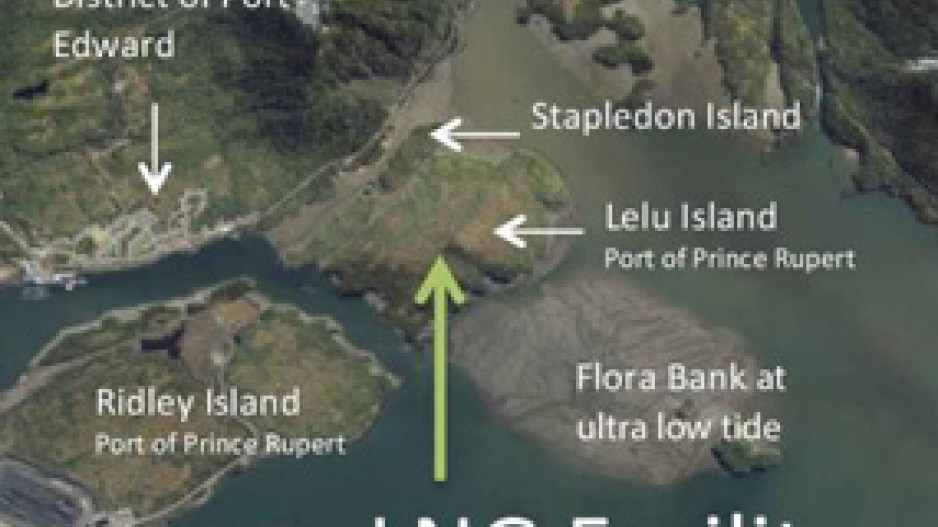A dispute between the elected and non-elected hereditary chiefs of the Lax Kw’alaams Band over the Pacific NorthWest LNG project on Lelu Island in Prince Rupert is raising potentially thorny legal and political questions.
When First Nations have both hereditary governance and elected chiefs and band councils, who ultimately represents the people on land-use issues off reserve?
Until recently, the Lax Kw’alaams appeared to be unified in its opposition to the Pacific NorthWest LNG project.
They not only rejected a $1.2 billion offer of land and cash to support the project, but also launched a title claim on Lelu Island, where the gas export plant would be built.
But since then, the band had an election, and its new mayor, John Helin, recently wrote to the Canadian Environmental Assessment Agency (CEAA) to express conditional support for the project.
That prompted a number of hereditary chiefs, including Chief Donald Wesley of the Lax Kw’alaams’ Gitwilgyoots tribe, to question Helin’s authority.
“Clearly, the hereditary chiefs are the proper title holders to all parts of our territory such as Lelu Island,” Wesley said in a written statement. “In this regard, band councils do not have any jurisdictional authority.”
Wesley might have a point, according to Robin Junger, aboriginal law specialist with McMillan LLP.
“It is not the case that Indian Act bands always have the authority to deal with rights and title issues,” he said. “It can vary from nation to nation, and the biggest factor is whether there is another governance system – a hereditary governance system – that remains in play.”
The Lax Kw’alaams is an alliance of nine tribes. Each has its own hereditary house system. In deference to hereditary chiefs, the Lax Kw’alaams do not use the word “chief” for their elected leaders. They call their head councillors “mayor.”
Wesley insists that Helin and the new band council do not have the authority to reverse a decision that was decided by a show of hands in a series of community meetings.
“Their authority is only on-reserve,” Wesley told Business in Vancouver. “We feel that we do have a say in our traditional area that we occupy.”
Historically, Lelu Island was not occupied, Wesley said, but it was used by a number of different tribes in the region, including the Gitwilgyoots, for a variety of purposes.
That traditional use gives the Gitwilgyoots some claim over the island, according to Wesley.
Doug Eyford, an aboriginal law expert with EMSP LLP and former federal chief treaty negotiator, said the dispute raises interesting questions.
But ultimately, he said, if he were advising a client who needed to consult First Nations on a development project, he would send them to the elected council.
“I’m not sure I buy into this theory that, because this project is being built on Lelu Island and Lelu Island isn’t part of a reserve, then the Indian Act-created chief and council aren’t capable of indicating whether the community supports it or not,” he said.
“They’re the group that is recognized by statute to represent the interests of that Indian Act band. But it raises very interesting questions because, obviously, within communities where there is a strong hereditary leadership, elected chief and council have to be conscious of the need to address their interests and involve them in decision-making.”
In some cases, Junger said, aboriginal communities have agreed to invest authority in elected band councils. But in other cases, where there is a history of hereditary governance, the elected council’s authority might be limited to governance on reserve land.
“In cases where the community has its own historic hereditary governance system,” Junger said, “it’s fairly common for the band not to represent the First Nation in respect of rights and title issues.”
The federal government has committed to developing “nation-to-nation” relationships with First Nations in an attempt to do a better job of getting their consent for projects like Pacific NorthWest LNG. But Junger said the Lax Kw’alaams case shows just how difficult that might be.
“Who are you going to get it from?” he wondered. “This is just one example of the situation. If you peel back this onion, it’s an issue all over the place.”
Lelu Island might not have been occupied in the past, but it’s being occupied now. A number of Lax Kw’alaams and their supporters have set up a protest camp there with two houses to accommodate LNG project opponents.




